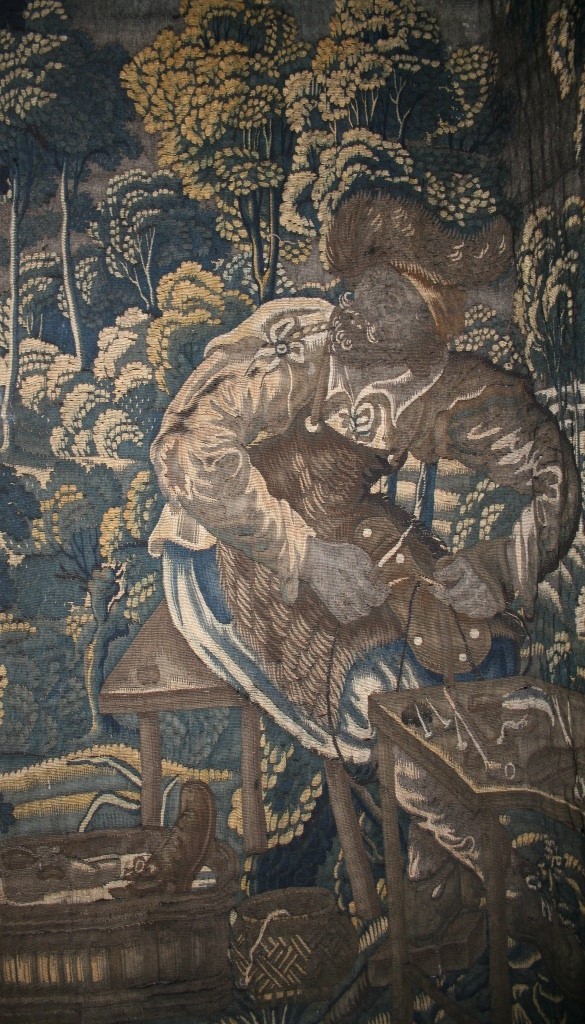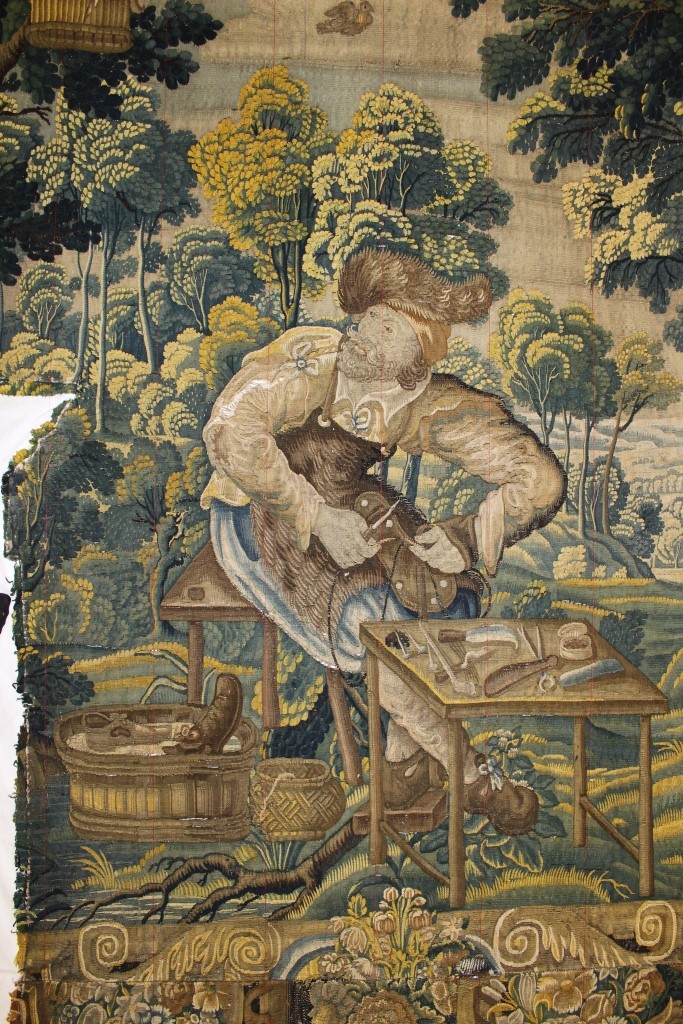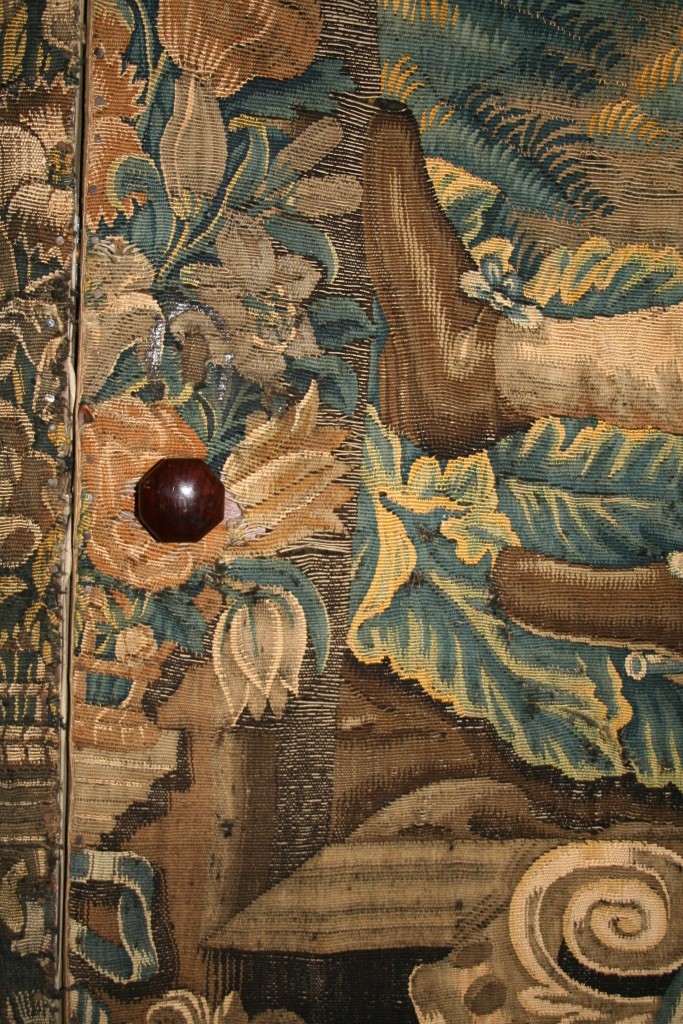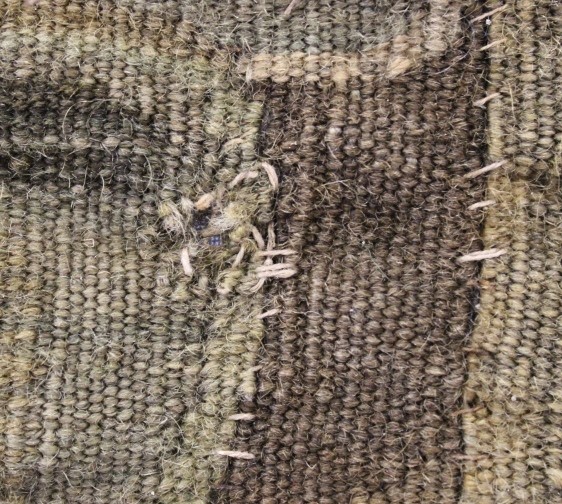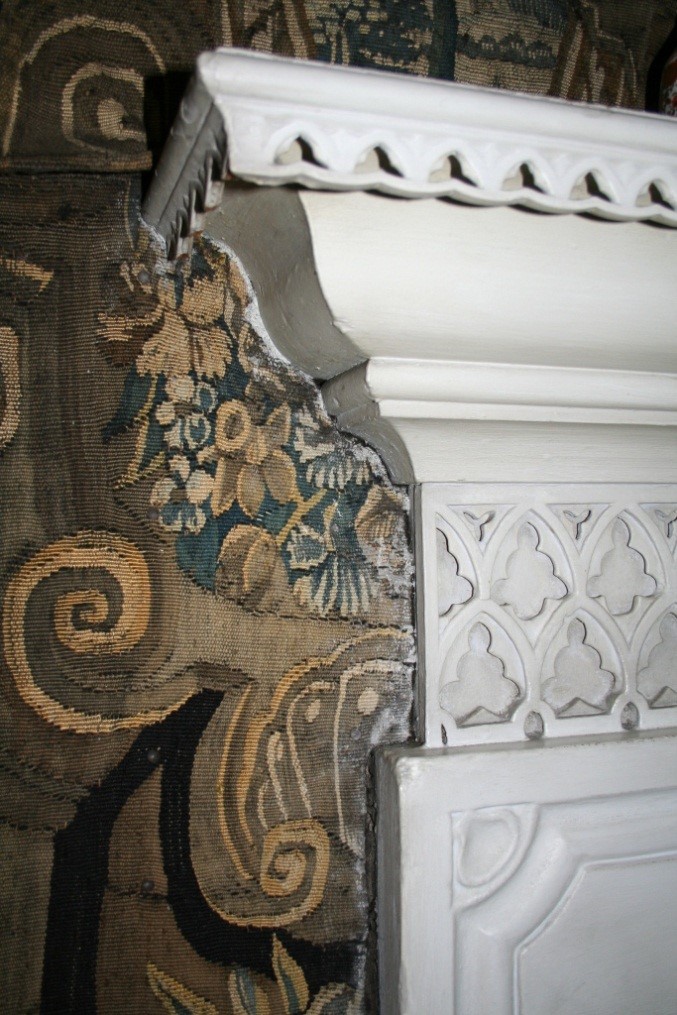In the nearly 400 years the Doddington tapestries have been in existence they have sustained a number of different types of damage. Here are some photographs of the damage that can be seen on the tapestries and an explanation of how the damage has been caused.
Loss of detail of the images
This was evident before the tapestries were wet cleaned. 250 years of dirt and soot from the open fire within the room had been deposited onto the tapestries obscuring much of the detail of the design, especially in the pale coloured areas such as the figures faces.
This soot and surface soiling can be acidic. These acidic conditions will undoubtedly have increased the rate of degradation of the wool and silk fibres of the tapestry contributing to some of the loss of the design in places. Wet cleaning the tapestries will have removed some of this acidity as well as the visible soiling, bringing the detail back into view.
Image 1 and 2. You can see in these images of the cobbler (one of the tapestries we are currently working on), just how dirty he was before wet cleaning compared with after, the features of his face were very difficult to see, especially his lovely curly beard!
Fading
Wool and silk yarns were used to weave the tapestries, these were all dyed using natural dyes (made with plants and insects). These dyes have faded over time due to exposure to day light often changing colour completely, as you can see in the image below where a section of the tapestry has been protected from the light by the skirting board. Ultra violet light (a component of day light and given off by most ordinary light bulbs) is particularly damaging, not only causing fading of colours but also causing an increase in the rate of decay of the fibres.
Image 3. Visible colour change under the skirting board
Opening slits
During the weaving process, natural slits are created within the weave (this is where the weaver has changed colour or to create a design feature). You can see how a slit is created in this image.
These slits were then stitched up once the tapestry was complete often using a linen thread. This thread is now brittle and weak and many of these slits have come open.
The weakening of the slit stitching is exacerbated by the original construction method of the tapestry. Tapestries are woven with the image on its side; this allowed the weaver to create better shading. The warp threads (the invisible undyed skeleton of the tapestry) would have been tensioned vertically on the loom during weaving, however once the tapestry is finished and hung they now run across the tapestry from left to right (See image 4). This means that instead of hanging on these strong warp threads the tapestry is now hanging on the finer weaker weft threads (the coloured wool and silk threads which are woven in and out of the warps to make the image). This also means that the slits created during the weaving process run horizontally across the tapestry (as you can see in image 5) and are therefore required to take the weight of the tapestry, this is why many of the larger longer slits have opened up with time.
Image 4. Woven slit
Image 5. A woven slit that has become broken
Broken warps and loss of weft
Holes in the tapestries are found when warp threads have broken or when the weft threads have been worn away or have become so brittle they have been lost, leaving behind bare exposed warp threads. Often a hole is a combination of both broken warps and lost weft.
The causes of these holes are varied. Many of the broken warps have been caused by the 1600 plus nails that were used to attach the tapestries to the walls in 1762 and also where cuts have been made for fixtures and fittings, such as door knobs and light switches.
Insects have also caused some damage to both the warps and weft, particularly moths and carpet beetle larvae. In some places, you can see where a moth has travelled across the tapestry like a little lawn mower, trimming the weft right down to the warps.
Other places where we have found a particularly large amount of weft fibre loss is in the dark brown wool areas. This is likely due to the way this colour was dyed, using Iron as a mordent to fix the dye, leading to an increased rate of decay than the other colours. You can see in image 6, the strip of dark brown wool beneath the sole of the shoe is very degraded compared to the surrounding colours.
Image 6. ‘The Hunter’ tapestry close up, before conservation
Some of the silk weft has also become very brittle and has worn away. You can see this in the arm of the cobbler’s shirt, much of the silk has gone, leaving bare warp threads exposed.
Image 7. Missing silk weft, in the Cobbler’s shirt
Historic alterations
When the tapestries were hung in the Holly bedroom in 1762 they were already over 100 years old, repairs were made to them by a local tailor. Holes were darned, opening slits were closed and patches were stitched over large holes. In some places these repairs have caused added tension to the tapestries where they have pulled together too tightly. Below is an example of some of the darned holes we have found, you can also see a couple of slits that have been sewn together in a heavy-handed manor by the tailor using a thick thread.
Image 8. Old repair
Sets of tapestries were often made for a room, equalling the width and height of the room they were commissioned for. These tapestries however were either second hand or had come from another part of Doddington Hall (we don’t know their whereabouts before they are mentioned as being hung in the Holly room in 1762) they therefore did not fit the room. They were cut around the doors and the fireplace, overlapped, patched and nailed to the walls on all sides and into the corners of the room. Image 9, shows how the tapestry has been cut to fit around the fireplace. Paint and plaster can also be seen on the surface of the tapestries around the edges.
Image 9. Close up of how the tapestry fitted around the fireplace
Environmental Factors
Over 400 years there has also been a weakening of the wool and silk fibres of the tapestries that can’t be seen. This is caused by a number of factors. Firstly, the environmental conditions the tapestries are kept under are constantly changing due to the weather outside. If this is fluctuating from damp to dry and cold to hot the tapestries will expand and contract causing stress to the fibres.
We hope that after cleaning and full conservation stitching repairs (which we will tell you about in a subsequent blog) the tapestries will be able to be displayed safely back in the Holly Bedroom at Doddington Hall for many more years to come.
For images and weekly updates on the conservation project, follow us on Instagram at conservation_at_doddington.

